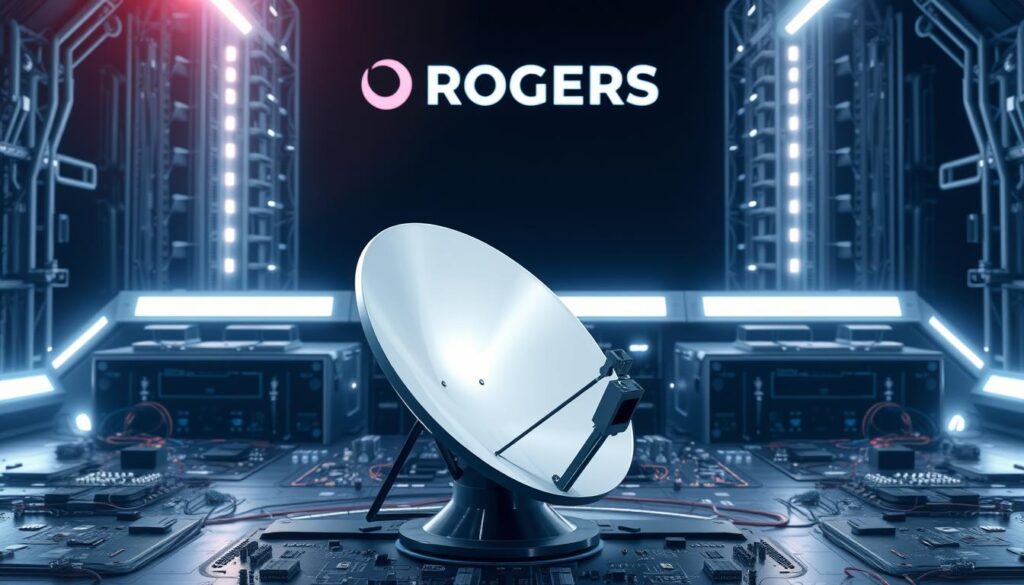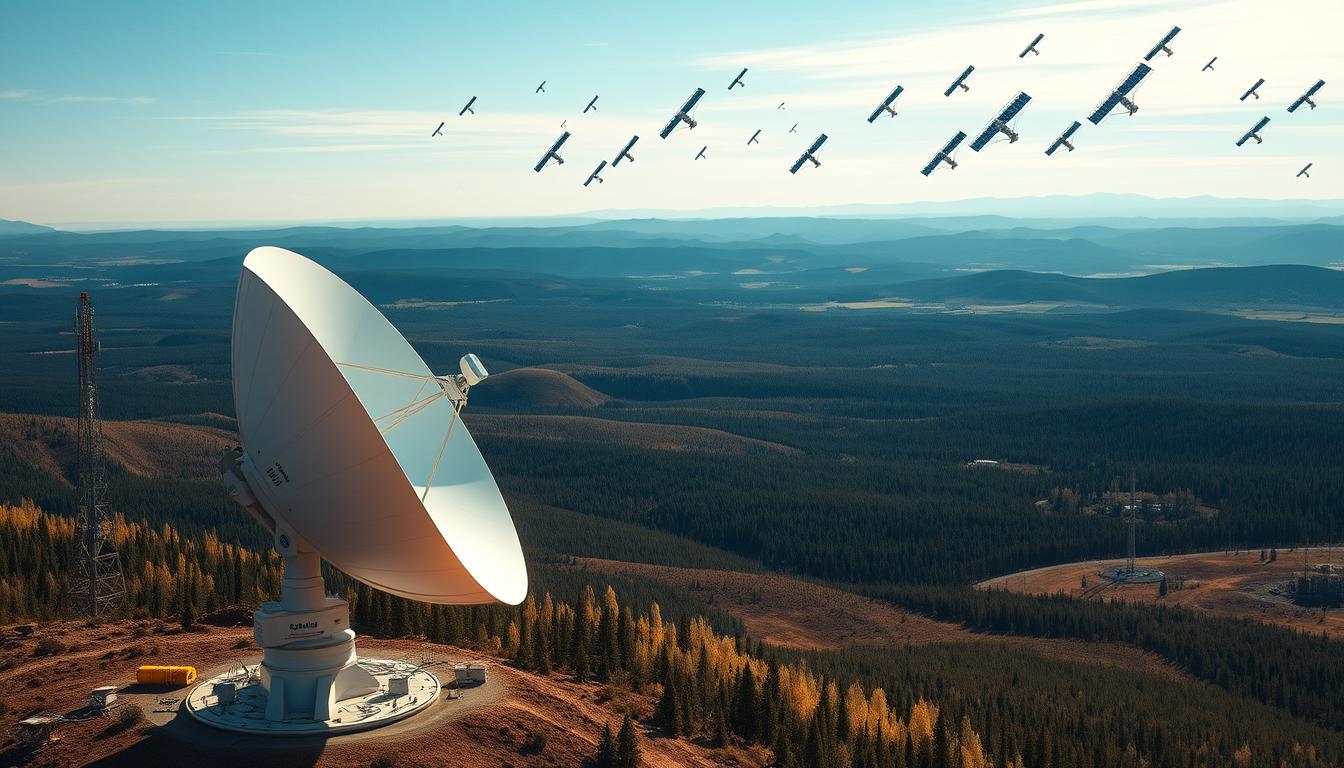Over 82% of Canada’s landmass—home to nearly 2 million people—lacks traditional cellular coverage. On July 15, 2025, this reality shifted when Rogers Communications launched a first-of-its-kind solution: direct satellite-to-phone service. This innovation brings reliable connections to every corner of the country’s 5.4 million square kilometers.
The partnership leverages cutting-edge low-orbit satellite technology to eliminate dead zones. Rural communities, emergency responders, and travelers now access critical communication tools where ground networks never reached. One industry analyst called it “the most significant leap in North American telecom since 5G.”
This breakthrough builds on decades of wireless leadership. The same company that made Canada’s first mobile call in 1985 now delivers next-gen infrastructure. For remote regions, it means video calls in fishing villages, real-time weather updates for truckers, and lifelines during wildfires.
Key Takeaways
- Satellite service now covers 100% of Canada’s geography
- Partnership combines space tech with existing cellular networks
- Addresses connectivity gaps affecting 1 in 5 rural residents
- Enables emergency alerts in previously unreachable areas
- Builds on 40-year legacy of telecom innovation
Overview of the Rogers Satellite Launch
Canada’s telecom landscape changed overnight with a groundbreaking connectivity experiment. Starting July 15, 2025, every mobile user nationwide gained access to satellite-powered texting – regardless of their current provider.
Beta Trial Announcement and Free Access
The free public beta runs through October 2025, offering two essential services:
- Unlimited SMS messaging
- Emergency text-to-911 functionality
This open-access approach lets users test reliability in extreme conditions – from Arctic tundras to Rocky Mountain passes. “We’re stress-testing our systems with real-world usage patterns,” stated a company representative.
Key Details from the Press Releases
Post-beta pricing reveals strategic market positioning:
| User Type | Monthly Cost | Special Conditions |
|---|---|---|
| General Public | $15 | No contract required |
| Beta Participants | $10 | First 12 months only |
| Ultimate Plan Subscribers | Free | Automatic enrollment |
The three-month trial serves dual purposes. It collects technical data while building public trust. Early adopters get permanent discounts, creating loyalty before commercial rollout.
Network engineers specifically designed the October launch timeline. Full service begins before winter storms test emergency systems nationwide. This strategic window ensures reliability when communities need it most.
Technology Behind Rogers Satellite Service
The groundbreaking partnership merges orbital infrastructure with terrestrial networks to redefine connectivity. This hybrid approach uses existing smartphone hardware while pushing transmission limits beyond traditional cell towers.

Orbital Networks Meet Ground Spectrum
Rogers’ licensed radio spectrum acts as the bridge between phones and satellites. When devices lose tower signals, they instantly ping orbiting relays using modified 4G/5G protocols. Engineers overcame signal delays by compressing data packets 73% smaller than standard cellular transmissions.
The system automatically prioritizes emergency messages. “Text-to-911 jumps queue even during network congestion,” confirmed a beta tester’s report. This life-saving feature operates without app downloads or manual activation.
Why Low Orbit Changes Everything
Satellites circling 340 miles high slash transmission times to 25 milliseconds – 40x faster than traditional models. This table shows critical improvements:
| Feature | LEO Satellites | Traditional Satellites |
|---|---|---|
| Altitude | 340-1,200 miles | 22,236 miles |
| Latency | 25-50 ms | 600+ ms |
| Coverage Area | 200-mile radius | Continental |
| Required Equipment | Standard phones | Specialized dishes |
Frequent satellite handoffs maintain steady connections as orbital units pass overhead. The technology currently supports 160-character texts but will handle voice calls by Q2 2026. Users need clear skies – dense forests or storms may disrupt signals until more satellites launch.
Deep Dive: SpaceX’s Cellular Starlink Arrives in Canada Through Rogers
Spanning 5.4 million square kilometers, Canada’s new network bridges vast distances between remote communities. This system delivers 2.5 times more coverage than any domestic carrier’s existing infrastructure. Geographic analysis reveals critical service areas:
Expanded Coverage and Unique Network Benefits
Rocky Mountain trails and Hudson Bay shorelines now have reliable connections. The table below shows coverage advantages:
| Region | Previous Coverage | New Satellite Access |
|---|---|---|
| Northern Highways | 12% | 100% |
| Gulf of St. Lawrence | 29% | 98% |
| Arctic Territories | 8% | 95% |
Compatible Devices and User Requirements
Current supported phones include:
- iPhone 13-16 series
- Samsung Galaxy S25 models
- Select Motorola devices
Users need clear sky visibility and automatic network switching enabled. Voice capabilities arrive in 2026.
Comparisons with Competing Services
Global satellite providers show distinct approaches:
| Provider | Monthly Cost | Device Restrictions |
|---|---|---|
| Rogers | $10-$15 | Multiple brands |
| T-Mobile (US) | $10 | Android only |
| Apple | Free* | iPhone exclusive |
*Emergency use only. Canadian pricing includes full messaging services.
Conclusion
Canada’s connectivity landscape has reached a turning point. The beta trial demonstrated how satellite-powered technology transforms communication in wilderness areas and northern communities. Search teams in British Columbia already report faster response times during backcountry emergencies thanks to reliable text capabilities.
This service bridges critical gaps between urban and rural networks. Over the next months, upgrades will add voice calls and data features – a game-changer for remote healthcare and education. The system’s success could inspire similar solutions in Alaska or Australia.
Rogers Communications achieved what ground-based infrastructure couldn’t in 40 years. Their approach makes advanced connectivity available canadians without requiring new devices. As global demand grows for satellite solutions, this partnership sets a blueprint for merging space technology with existing cellular networks.
The true victory lies in safer travels for truckers, real-time storm alerts for fishermen, and emergency access for hikers. These advancements prove reliable communication isn’t just convenient – it’s lifesaving infrastructure.


